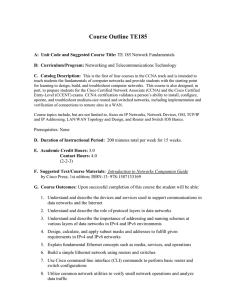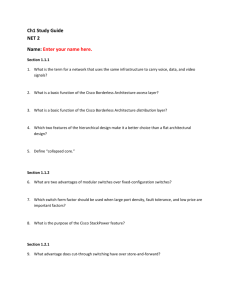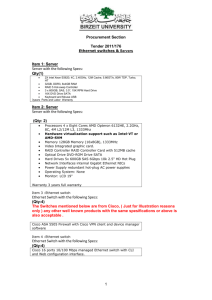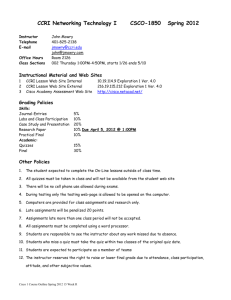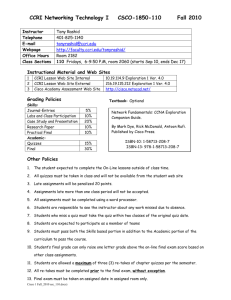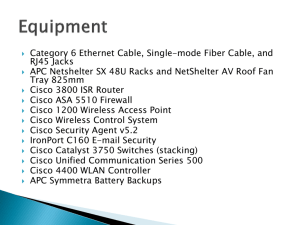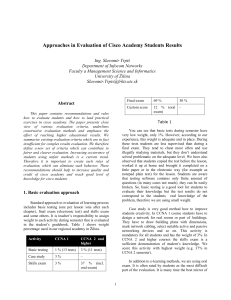Course outlines
advertisement
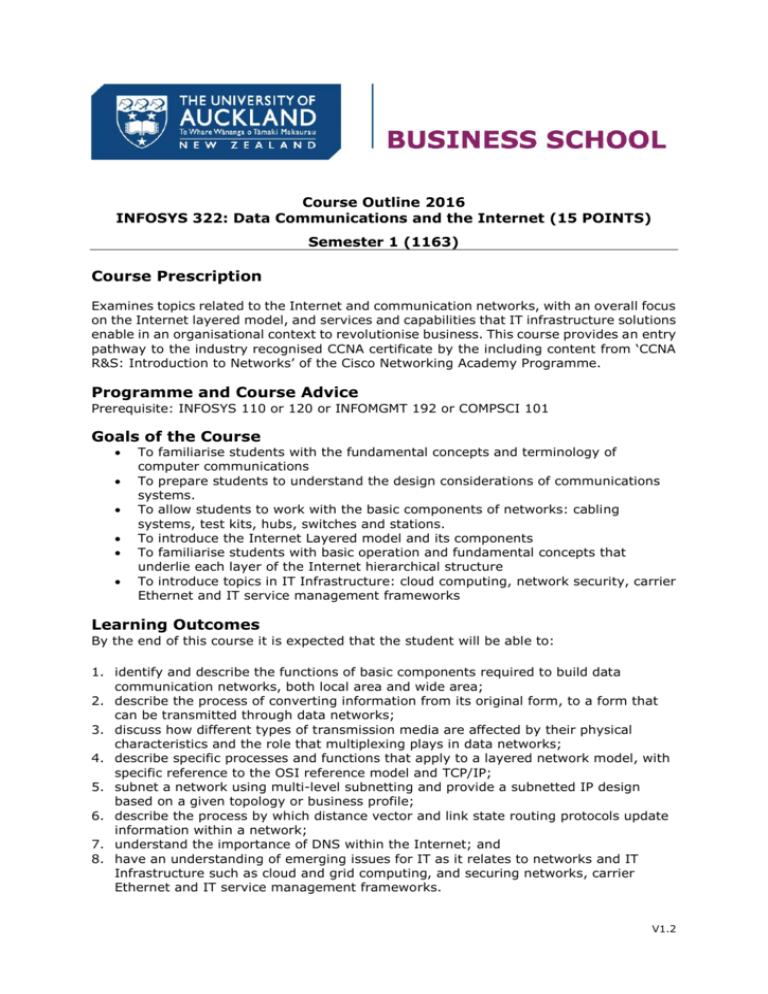
Course Outline 2016 INFOSYS 322: Data Communications and the Internet (15 POINTS) Semester 1 (1163) Course Prescription Examines topics related to the Internet and communication networks, with an overall focus on the Internet layered model, and services and capabilities that IT infrastructure solutions enable in an organisational context to revolutionise business. This course provides an entry pathway to the industry recognised CCNA certificate by the including content from ‘CCNA R&S: Introduction to Networks’ of the Cisco Networking Academy Programme. Programme and Course Advice Prerequisite: INFOSYS 110 or 120 or INFOMGMT 192 or COMPSCI 101 Goals of the Course To familiarise students with the fundamental concepts and terminology of computer communications To prepare students to understand the design considerations of communications systems. To allow students to work with the basic components of networks: cabling systems, test kits, hubs, switches and stations. To introduce the Internet Layered model and its components To familiarise students with basic operation and fundamental concepts that underlie each layer of the Internet hierarchical structure To introduce topics in IT Infrastructure: cloud computing, network security, carrier Ethernet and IT service management frameworks Learning Outcomes By the end of this course it is expected that the student will be able to: 1. identify and describe the functions of basic components required to build data communication networks, both local area and wide area; 2. describe the process of converting information from its original form, to a form that can be transmitted through data networks; 3. discuss how different types of transmission media are affected by their physical characteristics and the role that multiplexing plays in data networks; 4. describe specific processes and functions that apply to a layered network model, with specific reference to the OSI reference model and TCP/IP; 5. subnet a network using multi-level subnetting and provide a subnetted IP design based on a given topology or business profile; 6. describe the process by which distance vector and link state routing protocols update information within a network; 7. understand the importance of DNS within the Internet; and 8. have an understanding of emerging issues for IT as it relates to networks and IT Infrastructure such as cloud and grid computing, and securing networks, carrier Ethernet and IT service management frameworks. V1.2 Content Outline Semester Week 1 2 3 4 5 6 7 8 9 10 11 12 13 Discussion Topics Course Introduction – Structure + Assessment Network Topologies, Protocols and Communications Layered Model, Encapsulation, Addressing PHYSICAL LAYER - Analog Signals Digital Signals + Transmission Impairment Transmission Time + Serial and Parallel Async and Sync Multiplexing-TDM + FDM + WDM DATALINK LAYER – Multiple Access Random - Controlled - Channel Framing + Ethernet Random - Controlled - Channel Framing + Ethernet (cont) L2 Addressing + ARP + Hub + Switching Flow Control (Sliding Windows) + Error Control (ARQ) Hubs + Switches + Routers - Collision Domains Circuit + Packet [Switching] NETWORK LAYER - Logical Addressing IP Addressing - Simplified Subnetting IPv6 TRANPORT LAYER - Port Addresses TCP-UDP Flow Control APPLICATION LAYER - Session - Presentation - Application Email-FTP DHCP-SMB-Telnet IT INFRASTRUCTURE – Network Security, Clusters – Grids – Clouds IT INFRASTRUCTURE – Carrier Ethernet, IT service management frameworks NB: The flow of the course is intended to allow flexibility for the precise schedule of delivery ie. a topic that may be set to deliver in week 3 might extend to week 4, or a topic in week 9 may be covered in week 8. Learning and Teaching The course is delivered within the following components: Lectures: Laboratories: Online Curriculum: Mid Term test Part: Final Exam: Self-Study: 3x1-hour lectures per week 1x2-hour laboratory per week based on hands-on tasks in the context of data networks Cisco Certified Networking Academy - includes online assessment. Written test Written test Students are expected to learn any online curriculum content that is not covered in the prescribed textbook, or discussed in lectures based on self-study V1.2 Teaching Staff Koro Tawa Room 482, OGG Building k.tawa@auckland.ac.nz Extn: 87459 Office Hours: TBA Course Coordinator: TBA Learning Resources Prescribed Textbook (Students must have) Forouzan, B. (2013). Data Communications and Networking (5th Ed). McGraw-Hill ISBN-13 978-0-07-337622-6. Website: http://www.mhhe.com/forouzan Lecture Notes – These are provided online via Cecil Online Curriculum http://cisco.netacad.net Workstations/Hubs/Switches/Routers/Cables - Provided in lab Inclusive Learning Students are urged to discuss privately any impairment-related requirements face-to-face and/or in written form with the course convenor/lecturer and/or tutor. Student Feedback Based on previous student feedback, it is important to understand that this can be a challenging course. You will be challenged within the first two weeks to reflect on the content that has been delivered to date, and check to see if this is the right course for you to continue with. Assessment Mid Semester Test (Parts 1 and 2) Lab Components Final Exam Total 30% 30% 40% ____ 100% Requirements to pass INFOSYS 322 1. Pass the Final Examination 2. Achieve 50% or higher of the total marks allocated to the final examination and internal coursework. Notes Students are NOT required to pass each individual coursework component. V1.2 The broad relationship between these assessments and the course learning outcomes is as follows: Learning Outcome 1 2 3 4 5 6 7 8 Mid Semester Test X X X X X X Cisco Modules and Exam, Lab Activities X X X X X X Final Exam X X X X X X X V1.2

